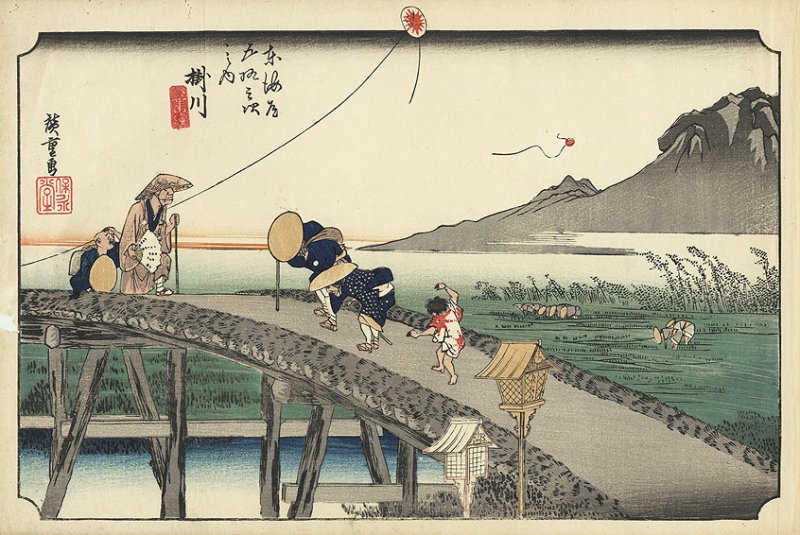| |
Hiroshige(1797 - 1858)Distant View of Mount Akiba at Kakegawa (Station
27)
|
|

"Distant View of
Mount Akiba at Kakegawa "
(掛川 秋葉山遠望 Kakekawa Akiba-yama embo)
Series: "Fifty-three Stations of the Tokaido" (東海道五拾三次之内, 保永堂版東海道)
1896 Hoeido Reprint
Comment - The woodblock "Distant View of Mount Akiba at Kakegawa" shows a landscape from the Hoeido Tokaido series. In the foreground, travelers cross a a high trestle-bridge over the Kake River at Kakegawa on a windy day. An old couple is struggling against a strong wind, followed by a boy making a mocking gesture; another boy is watching a Circular kite (Maru-tako, 丸凧) with a radiating sun up in the air. Another cirlular kite with a broken line is floating away. In the background, peasants are planting rice and in the distance, Mount Akiba rises in the mists. A shrine standing on the top of a mountain near this station attracted worshippers from all over Japan who came to pray for protection against fire.
Station twenty-seven on the "Tôkaidô road", Kakegawa is located in what is currently Shizuoka Prefecture. Here Hiroshige has created a playful scene in which a kite flies beyond the borders of the picture, infusing the image with a sense of energetic movement. Framing devices such as the black outline around each of HIROSHIGE’s Tokaido prints published by Hoeido publishing house were originally adopted from the Western practice of framing a composition, and were an innovation introduced to Japanese art largely through woodblock prints. In this case, it also indicates that the prints were intended to be released as a bound album once the series was complete, and customers that bought the prints one by one as they were issued could also have had the set bound into an album by the publisher once they had all fifty-five prints.
Kakegawa-juku was originally the castle town of Kakegawa Castle. It was famous because Lord of Tosa (Yamauchi Kazutoyo) rebuilt the area and lived there himself. It also served as a post station along a salt road that ran through Shinano Province between the modern-day cities of Makinohara and Hamamatsu.
Reprint - In 1896 (Meiji 29) the descendents of the original Tokaido publishing house 'Hoeido', embarked on a project, to release their most famous publishing project, a commemorative issue of Hiroshige's "Fifty-three Stations of the Tokaido". The blocks for this series were no longer in existence and they recut a new set of blocks for the entire series. As the original publisher of the Hiroshige's masterwork series, Hoeido held the rights to release a reprint edition produced exactly as the first one was produced. Artists painstakingly recut a set of blocks for each print and printed the new set. The result was a fantastic re-release of Hiroshige's masterwork series. Hoeido published 500 reprint sets of the Hoeido series and then halted production. Therefore these sets are very rare today.
Series - "Fifty-three Stations of the Tokaido" (東海道五拾三次之内, 保永堂版東海道)("Hoeido" Edition"). Print No. 27 is the only one from Kakegawa Station containing kites. The Gyosho-, Reisho-, Jimbutzu-, and Tate-e-Edition contain kites from Fukuroi Station. For information about other Series of Hiroshige, refer to HIROSHIGE's "Tokaido" and other Series.
Kunisada (Toyokuni-III) helped to promote Hiroshige's first 53 Stations on the Tokaido series which was being issued at the same time, and issued his own Tokaido series often named 'Bijin Tokaido'.
Several other leading artists of these times issued a plethora of 'Tokaido series'.
Artist - see Biography
Signature - Hiroshige ga 広重画 above his red seal (center left)
Publisher - Takenouchi Magohachi (竹内 孫八) (Hoeido Publishers, 保永堂)
Image Size - 25.5 x 39.2 cm (8 7/8" x 13 1/2") + margins as shown
Condition - single sheet; nishiki-e (cloured woodblock); Horizontl ôban; Yoko-e (landscape)
Copyright 2008 ff: Hans P. Boehme